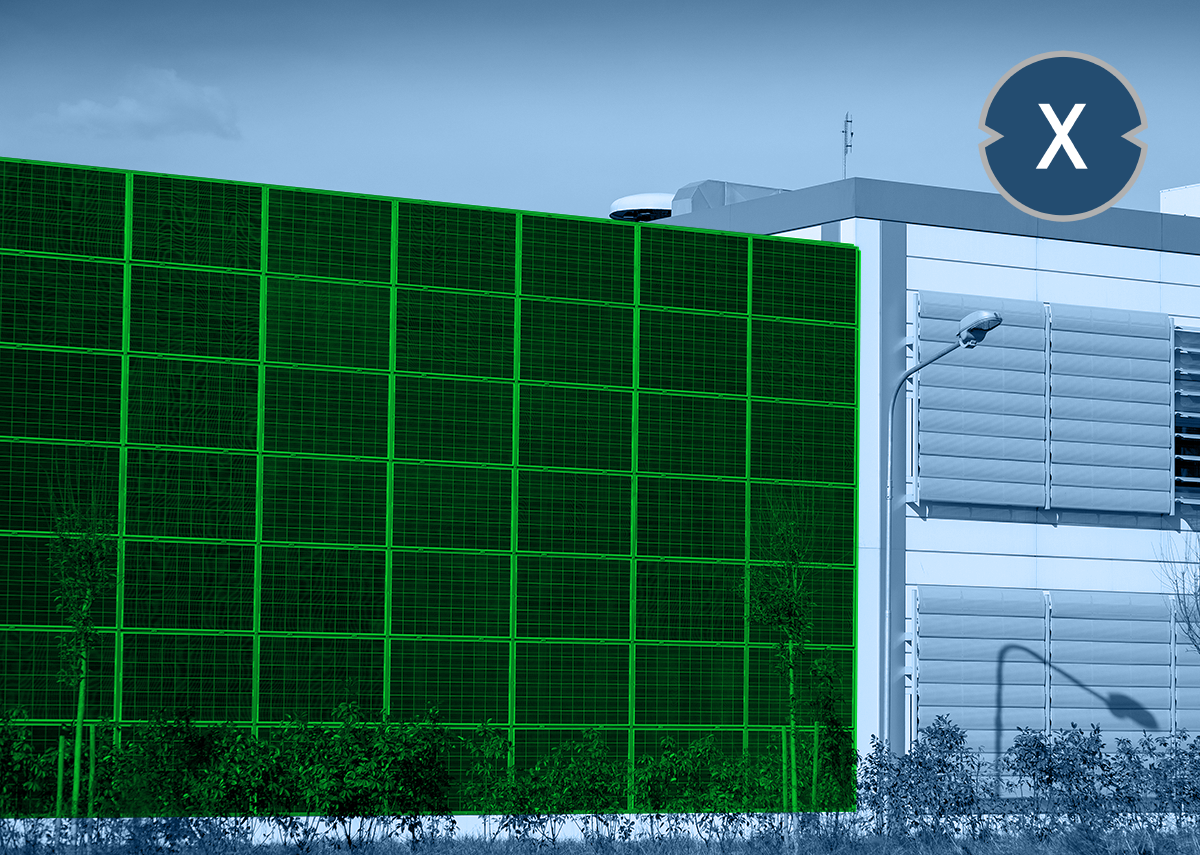
Solar facade – solar facade solution for PV modules and mounting systems – Image: Xpert.Digital – marco mayer|Shutterstock.com
Solar facade solar system for trade, industry, logistics and commerce
Compared to traditional roof-mounted solar panels, a vertical orientation prevents any snow accumulation. Among other things, it was found that the solar gain is increased in winter because the solar modules are aligned more towards the lower sun angle in winter. Reflective snow on the ground has also been found to increase solar energy by up to 50%.
Energy generation through solar facades is part of a solar system made up of fences and walls that have the vertical or vertical orientation of the modules in common.
With solar facades, the industry has another opportunity to expand its own autonomous power supply, see also Amazon Logistics . In addition to solar carports and rooftop solar systems, vertically positioned solar modules on walls and fences are a complementary alternative.
Suitable for:
Solar facade example on a residential building
White building with solar panels on the outside wall – Image: Xpert.Digital /Aleksandra Suzi|Shutterstock.com
Solar facade: planning and selection
Correct planning and selection of the appropriate solar mounting system . Just as solar systems and mounting systems exist in different designs, there are also different types of facades, which not only depend on the type of building (including house, warehouse) and type of construction (including wooden house, brick building, concrete building, lightweight steel hall), but also differ in the construction:
- Lightweight construction: timber construction, lightweight steel construction and drywall construction
- Solid construction: reinforced concrete, lightweight concrete, aerated concrete, brick masonry and sand-lime brick
- Hybrid construction: combination of solid and lightweight construction methods
There is no standard technique for everyone. Every solar wall or facade has its own characteristics. Highlights must be taken into account and attachment with the photovoltaic mounting system does not work the same for everyone. As a rule, special planning and adjustments are necessary for this.
the right façade solar mounting system differs from others in that it leaves a gap between the wall and the modules so that the air can continually circulate and thus cool the modules. Because as the temperature rises, the solar modules generate less electricity.
Whether the installation is worthwhile in any case depends on the size of the area and the orientation of the solar modules. Especially in industry, especially in logistics, there are large, interesting vertical surfaces that are interesting for photovoltaics in addition to a solar roof system.
More options and technologies
In North Rhine-Westphalia (NRW), 68 terawatt hours of solar power were calculated on the approximately eleven million roofs in NRW. The potential of possible solar walls or solar facades was not taken into account. Not every building wall is suitable for photovoltaics. However, if you consider that buildings usually have a larger facade area than roof area, there is possible additional photovoltaic potential of the same magnitude.
For vertically installed solar modules, thin-film PV modules are used more frequently than the usual crystalline solar modules on roofs. When used vertically, thin-film PV modules have comparatively better efficiency thanks to the angle of radiation.
Different cell technologies of solar modules:
- Monocrystalline silicon
- Multicrystalline silicon
- Strip-pulled silicon
- Thin film technologies
Other possible solar facade modules:
- Glass-glass modules have an extremely long service life thanks to the use of glass on the front and back of the solar module.
- Thin film PV solar facade for vertical walls.
Dense-film solar modules are cheaper and more efficient than thin-film modules. However, with thin-film solar modules, architects have much greater freedom of design. For example, rollable solar awnings can be operated using thin-film technology.
Printable photovoltaic modules: Solar power can also be generated on the building facade, not just on the roof
It is also interesting that printable photovoltaic modules are also possible.
PV elements and printed images will be attached to the project partner Glassbel's office building in 2015 - Image: © Glassbel | Source: Pressbox
With Via Solis, photovoltaic elements of various shapes and colors are manufactured with which architects can realize their visions. Instead of rectangular, the modules can also be square, triangular or round and are made in all RAL colors. Via solis, colored, semi -transparent solar glasses, which is developed by the innovative glass manufacturer Glassbel and already used in normal glass facades, is used, ”reports Dr. Juras Ulbikas from the Applied Research Institute for Prospective Technologies (Protech) in Vilnius, which heads the SmartFlex project. "The desired shapes, colors and sizes of the solar elements are transmitted directly to the production line by the architect's planning software." ( Source )
“With the help of intuitive planning software, architects should be able to design solar modules that fit their building exactly - the glass module elements can be round or triangular, for example,” explains Paul Grunow, head of the Photovoltaic Institute Berlin. “The special thing is that the production process for the extraordinary solar elements should be largely automated. This is completely new; so far only standard modules have been mass-produced or tailor-made solar products have been painstakingly handcrafted. SmartFlex strives for highly smart and flexible series production that also makes customized solar elements affordable.”
“Solar power can also be generated on the building facade, not just on the roof. Building-integrated photovoltaics has great potential that has not yet been fully exploited,” reports Dr. Juras Ulbikas, head of the research group at the Applied Research Institute for Prospective Technologies (ProTech) in Vilnius, Lithuania, and coordinator of the SmartFlex project. “We are working on a plug & play solution for buildings that is easy to install and meets the needs of architects and installers - an ambitious goal. I am very pleased that we were able to attract very high-caliber partners for this.” In addition to ProTech, the Photovoltaic Institute Berlin and Glassbel, the project partners also include the internationally active mechanical engineering company Mondragon Assembly, the solar system manufacturer Via Solis, the Swiss Competence Center for Building-Integrated Photovoltaics (SUPSI ), the planning software developer Creative Amadeo and the agency Sunbeam Communications, which specializes in renewable energies. ( Source )
- Plan photovoltaics for warehouses, commercial halls and industrial halls
- Industrial plant: Plan a photovoltaic open-air system or open-space system
- Plan solar systems with photovoltaic solutions for freight forwarding and contract logistics
- B2B solar systems and photovoltaic solutions & advice
That's why Xpert.Solar for solar facade or solar wall facade solutions. Advice and planning for PV modules and solar mounting systems
I would be happy to serve as your personal advisor.
You can contact me by filling out the contact form below or simply call me on +49 89 89 674 804 .
I'm looking forward to our joint project.
Xpert.Digital – Konrad Wolfenstein
Xpert.Digital is a hub for industry with a focus on digitalization, mechanical engineering, logistics/intralogistics and photovoltaics.
With our 360° business development solution, we support well-known companies from new business to after sales.
Market intelligence, smarketing, marketing automation, content development, PR, mail campaigns, personalized social media and lead nurturing are part of our digital tools.
You can find out more at: www.xpert.digital – www.xpert.solar – www.xpert.plus

